Antonio del Pollaiuolo
Antonio del Pollaiuolo (UK: /ˌpɒlaɪˈwoʊloʊ/ POL-eye-WOH-loh,[1] US: /ˌpoʊl-/ POHL-,[2] Italian: [anˈtɔːnjo del pollaˈjwɔːlo]; 17 January 1429/1433 – 4 February 1498), also known as Antonio di Jacopo Pollaiuolo or Antonio Pollaiuolo (also spelled Pollaiolo), was an Italian painter, sculptor, engraver and goldsmith during the Italian Renaissance.
Antonio del Pollaiuolo | |
|---|---|
Antonio del Pollaiuolo | |
| Born | c. 17 January 1429 or 1433 |
| Died | 4 February 1498 (aged 69) |
| Known for | Sculpture, engraving, goldsmithing |
Notable work | Battle of the Nudes |
Biography
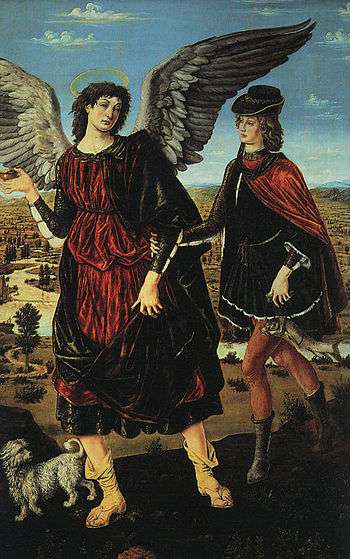
He was born in Florence. His brother, Piero, was also an artist, and the two frequently worked together. Their work shows both classical influences and an interest in human anatomy; reportedly, the brothers carried out dissections to improve their knowledge of the subject. They took their nickname from the trade of their father, who in fact sold poultry (pollaio meaning "hen coop" in Italian). Antonio's first studies of goldsmithing and metalworking were under either his father or Andrea del Castagno: the latter probably taught him also in painting. Other sources relate that he worked in the Florence workshop of Bartoluccio di Michele, where Lorenzo Ghiberti also received his training.[3] During this time, he also took an interest in engraving.
Some of Pollaiuolo's painting exhibits strong brutality, of which the characteristics can be studied in his portrayal of Saint Sebastian,[4] painted in 1473–1475 for the Pucci Chapel of the SS. Annunziata of Florence. However, in contrast, his female portraits exhibit a calmness and a meticulous attention to detail of fashion, as was the norm in late 15th century portraiture.
He achieved his greatest successes as a sculptor and metal-worker. The exact ascription of his works is doubtful, as his brother Piero did much in collaboration with him.[4] The fifteenth-century addition of the infant twins Romulus and Remus to an existing bronze sculpture of the Ancient Roman mythological she-wolf who nursed them has been attributed by some to him.[5]
He only produced one surviving engraving, the Battle of the Nude Men, but both in its size and sophistication this took the Italian print to new levels, and remains one of the most famous prints of the Renaissance.
In 1484 Antonio took up his residence in Rome, where he executed the tomb of Pope Sixtus IV, now in the Museum of St. Peter's (finished in 1493), a composition in which he again manifested the quality of exaggeration in the anatomical features of the figures. In 1496 he went to Florence in order to put the finishing touches to the work already begun in the sacristy of Santo Spirito. He died in Rome as a rich man, having just finished his mausoleum of Pope Innocent VIII, also in St. Peter's, and was buried in the church of San Pietro in Vincoli, where a monument was raised to him near that of his brother.[4]
His main contribution to Florentine painting lay in his analysis of the human body in movement or under conditions of strain, but he is also important for his pioneering interest in landscape. His students included Sandro Botticelli.
Major works
Paintings
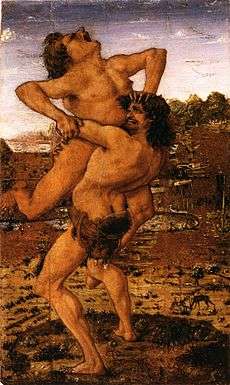 Hercules and Antaeus
Hercules and Antaeus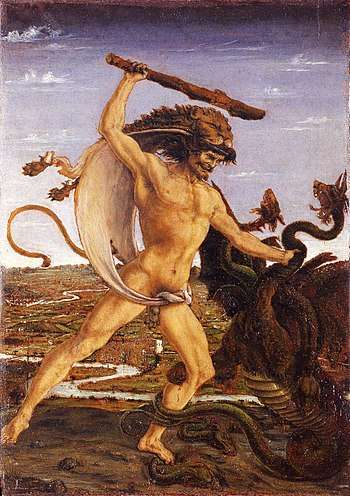
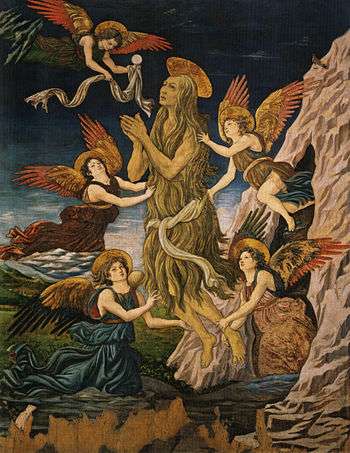 Assunzione di Santa Maria Maddalena
Assunzione di Santa Maria Maddalena_Apollo_and_Daphne.jpg)
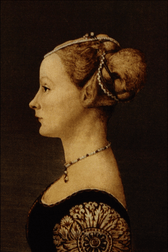 Profile of a Woman
Profile of a Woman
The above "Profile of a Woman" is a work of Piero del Pollaiolo, the brother of Antonio del Pollaiolo.
- Altarpiece for the Chapel of the Cardinal of Portugal (1467) - Fresco, San Miniato al Monte, Florence
- Portrait of a Young Woman (c. 1465) - Poplar panel, 52,5 x 36,2 cm, Staatliche Museen, Berlin
- The Saints Vincent, James and Eustace (1468) - Tempera on wood, 172 x 179 cm, Uffizi, Florence
- Apollo and Daphne (1470–1480) - Tempera on wood, 30 x 20 cm, National Gallery, London
- Martyrdom of Saint Sebastian (1473–1475) - Panel, 292 x 223 cm, National Gallery, London
- Portrait of a Young Woman (c. 1475) - Tempera on wood, 55 x 34 cm, Uffizi, Florence
- Hercules and the Hydra (c. 1475) - Tempera on wood, 17 x 12 cm, Uffizi, Florence
- Hercules and Antaeus (c. 1478)- Tempera on wood, 16 x 9 cm, Uffizi, Florence
- Portrait of a Girl - Panel, Museo Poldi Pezzoli, Milan
- Hercules and Deianira - Oil on Canvas, Yale University Art Gallery, New Haven
Sculptures
- Hercules and Antaeus
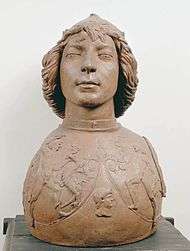 The sculpture of Warrior
The sculpture of Warrior- Hercules
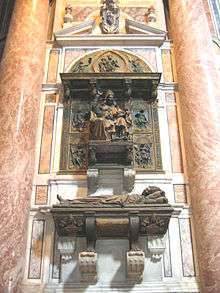 Tomb of Pope Innocent VIII, Pollaiuolo's second papal tomb
Tomb of Pope Innocent VIII, Pollaiuolo's second papal tomb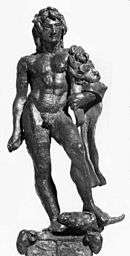 Hercules
Hercules- Depiction of a young woman
- St Christopher and the Infant Christ - Metropolitan Museum, New York
- Hercules (1475) - Bode Museum, Berlin
- Tomb of Pope Sixtus IV (1493) – Saint Peter's Basilica
Engraving
.jpg)
Notes
- "Pollaiuolo". Oxford Dictionaries UK Dictionary. Oxford University Press. Retrieved 31 May 2019.
- "Pollaiuolo". Collins English Dictionary. HarperCollins. Retrieved 29 July 2019.
- Renaissance Jewels and Jeweled Objects, Baltimore Museum of Art, 1968, p. 29: "Lorenzo Ghiberti (1378–1455) began his career under the goldsmith Bartoluccio di Michele ... Antonio Pollaiuolo (1433–1498) was also a pupil of Bartoluccio di Michele..."
-

- Capitoline Museums: Exhibition "The Capitoline She-Wolf", June–October 2000 Archived 2006-05-16 at the Wayback Machine
References
- Giorgio Vasari includes a biography of Pollaiuolo in his Lives of the Artists.
External links
| Wikimedia Commons has media related to Antonio Pollaiuolo. |
- Leonardo da Vinci, Master Draftsman, exhibition catalog fully online as PDF from The Metropolitan Museum of Art, which contains material on Antonio del Pollaiolo (see index)
- The Gubbio Studiolo and its conservation, volumes 1 & 2, from The Metropolitan Museum of Art Libraries (fully available online as PDF), which contains material on Antonio del Pollaiolo (see index)